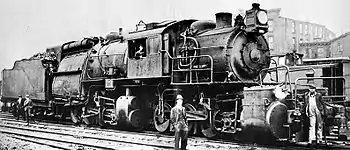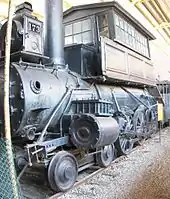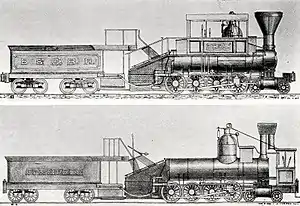Camelback locomotive
A camelback locomotive (also known as a Mother Hubbard or a center-cab locomotive) is a type of steam locomotive with the driving cab placed in the middle, astride the boiler. Camelbacks were fitted with wide fireboxes which would have severely restricted driver visibility from the normal cab location at the rear.

Development
The camel and the camelback design were developed separately by two different railroads in different eras. Though the name is often incorrectly used interchangeably, they had little in common other than the placement of the cab. Unlike the later Camelbacks, Camels had cabs that rode atop the boiler. Ross Winans wanted to put as much weight on the driving wheels as possible to increase traction. Camelbacks have a cab that straddles the boiler. While Camelbacks have the same idea of moving the cab forward, they had it for different reasons. Camelbacks were developed to allow for the use of larger fireboxes, such as the Wootten, which would obstruct the engineer's view from a conventionally placed cab. Camelbacks were particularly known for being used on the Central Railroad of New Jersey and the Reading Railroad.
Early use

The Baltimore and Ohio Railroad began to look into developing high-powered steam locomotives in the early 1840s, and in 1844–1847 built a series of locomotives nicknamed "muddiggers". As with many early B&O locomotives, a spur gear drive was used to connect the main shaft to the driving wheels. The long 0-8-0 wheelbase pushed this connection to the back of the locomotive and caused the floor of the cab to be lifted up above the whole assembly.

In 1853 Ross Winans, who had designed the "muddiggers", built the first of a series of 0-8-0 camel locomotives. These had long cabs that ran from the back of the smokebox to the front of the firebox. The firebox itself sloped back on the earliest models. The fireman worked from a large platform on the tender, and in some cases had a chute to allow him to deliver coal to the front of the grate.
Also in 1853, Samuel Hayes, the Master of Machinery for the railroad, had built a series of camel 4-6-0 locomotives for passenger service. The layout of the locomotive was roughly the same as for Winans' freight locomotives, except for the addition of the four-wheel leading bogie. Copies and variations on these locomotives were built into the 1870s, with the last retirements coming in the 1890s. These were called the "Hayes Ten-Wheelers".
The B&O examples burned conventional bituminous coal. The large fireboxes of these locomotives were made obsolete by better boiler design.
The B&O Railroad Museum has recently restored their Camel Locomotive and returned it to display. It now is in its original colors and markings for the first time since it left the Mt. Clare Shops in 1869. The Museum also has a Central of New Jersey Camelback, the No. 592, which was donated to the Museum in the 1950s.
The Wootten firebox

John E. Wootten developed the Wootten firebox to effectively burn anthracite waste, which was a plentiful, cheap source of fuel. Wootten determined that a large, wide firebox would work best. As the successful trailing truck used to support large fireboxes had not yet been developed, Wootten instead mounted his huge firebox above the locomotive's driving wheels. The problem now arose that with a cab floor at the then standard tender deck height, it would be impossible for the locomotive's engineer to see forwards around the firebox shoulders. Instead, a cab for the engineer was placed above and astride the boiler. The fireman, however, remained at the rear with minimal protection from the elements. This gave rise to the unusual shape of the camelbacks.
First Camelbacks
The first camelback, a 4-6-0 "Ten Wheeler", was built in early 1877 by the P&R's Reading, Pennsylvania shops. It proved a success; the fuel cost saving was about $2,000 a year (approx. $30,000 now). More were built for the Reading and other of the railroads operating in the anthracite regions. Others were constructed with different wheel arrangements. The largest ones had a 0-8-8-0 arrangement and were the only articulated Camelbacks built.
Later Camelbacks
By the 1920s, many Camelback Ten Wheelers with boiler pressure at 200psi were in daily use pulling passenger trains on the Lehigh Valley, the Philadelphia and Reading, and the Central Railroad of New Jersey, particularly the last two. For their relatively small size, they were powerful, quick to accelerate, very stable at speed, and could be operated as fast as 90 miles per hour such as on the Reading's Atlantic City line. Some continued in service into the 1950s.[1]
Safety Concerns

The Camelback's cab astride the boiler design raised concerns for its crew. The engineer was perched above the side-rods of the locomotive, vulnerable to swinging and flying metal if anything rotating below should break. In addition, the fireman was exposed to the elements at the rear. The Interstate Commerce Commission finally banned further construction of Camelbacks but gave exceptions to allow those under construction to be completed. In 1927, further orders were completely prohibited. The Philadelphia and Reading's crews referred to these locomotives as Mother Hubbards. The B & O crews, who had co-use of the Reading's line from Philadelphia to Bound Brook NJ (the Reading's junction with the Central RR of New Jersey's line to Jersey City across from New York City) called the Camelbacks "Snappers" in reference to a possible side rod snapping and flailing into the cab.[2] Many Camelbacks were converted into end-cab locomotives. The advent of the mechanical stoker which moved coal from the tender to the locomotive and its associated underfloor machinery placed cab floors and tender decks higher, and from that vantage point the engineer was safe.
Survivors
- Central Railroad of New Jersey 4-4-2 No. 592, at the Baltimore & Ohio Railroad Museum in Baltimore, Maryland.[3]
- Baltimore & Ohio Railroad 4-6-0 No. 173, at the Museum of Transportation, St. Louis.
- Baltimore & Ohio Railroad 4-6-0 No. 305 (formerly No. 217), at the Baltimore and Ohio Railroad Museum in Baltimore, Maryland.
- Delaware, Lackawanna & Western 4-4-0 No. 952, at the Museum of Transportation in St. Louis, Missouri.
- Reading Company 0-4-0 No. 1187, at the Strasburg Railroad in Strasburg, Pennsylvania (awaiting restoration)
- No. 1187 was previously on display at the Railroad Museum of Pennsylvania in Strasburg, Pennsylvania. Later, the locomotive was transferred to the Strasbourg Railroad until it was further moved again. It is currently in The Age of Steam Roundhouse Museum in sugar Creek, Ohio, which is currently trying to restore it to cosmetic condition to be on display in their roundhouse.
Owning railroads
References
| Wikimedia Commons has media related to Camelback locomotives. |
- Baltimore and Ohio Museum Website information
- Baltimore and Ohio Museum discussion of their Camelback display locomotive
- "CNJ No. 592". B&O Railroad Museum. Archived from the original on December 29, 2018. Retrieved March 25, 2019.
- Barris, Wes. "Camelback Locomotives". Archived from the original on 2004-12-07. Retrieved December 10, 2004.
- Sagle, Lawrence W. (1964). B&O Power: Steam, Diesel and Electric Power of the Baltimore and Ohio Railroad 1829–1964. Alvin F. Staufer.